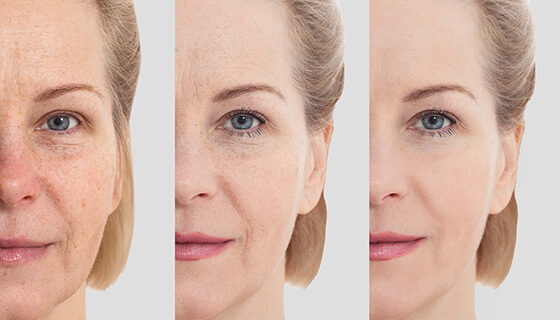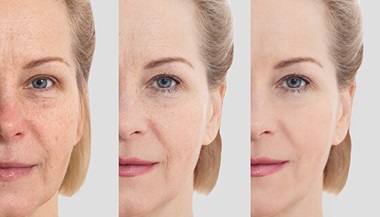Brow Lift
The brow and forehead are often the first areas to show signs of aging. A brow lift (also called a forehead lift) raises the brows in order to remove the appearance of forehead wrinkles and ease frown lines, and may also improve the appearance of the upper eye.
The operation itself carefully removes excess fat and skin and tightens the muscles in the forehead area. It can also correct sagging brows or ease deep furrows between the eyes.
What You Need to Know
- A brow lift is a cosmetic procedure to reduce the visible signs of aging and is most often performed on people ages 40 to 60.
- There are several types of brow lift surgery: common techniques include the classic forehead lift, the endoscopic forehead lift and the temporal lift.
- It is important for plastic surgeons to approach cosmetic procedures of the face in a holistic manner, looking for balance and harmony between each area of the face and its proportions. The surgeon may recommend a forehead lift along with a facelift for a smoother facial appearance.
- Expert skincare is essential in conjunction with a forehead lift or other facial cosmetic procedure.
Why consider a brow lift?
A brow lift can improve the appearance of people of any age who have furrows or frown lines such as those caused by stress or muscle activity over time, or as the result of inherited conditions, such as a low, heavy brow or furrowed lines above the nose. A brow lift can also help reduce excess skin of the upper eyelids.
Different Methods for Brow Lift
The plastic surgeon begins with a careful analysis of the person’s face, noting where volume has been lost and gravity has caused pulling or sagging. The forehead lift procedure replaces the lost volume and gently pulls specific areas to achieve a younger appearance.
There are a few options for brow lifts.
-
Classic or coronal brow lift. Once the patient is under anesthesia, the surgeon makes a cut or incision that starts at about ear level and goes across the top of the forehead to the other ear. In some cases, the surgeon may place the incision at the hairline. The surgeon then carefully lifts the skin of the forehead, removes any excess tissue and fat, and realigns the muscles if necessary. The surgeon may place the eyebrows at a higher level. Excess skin is trimmed away.
-
Endoscopic brow lift. This minimally invasive procedure is performed in the operating room and involves small incisions hidden within the hair. Fiberoptic equipment gently releases and elevates the tissue of the brows. For most patients, bruising is minimal and the healing time is generally faster than with a classic approach.
-
Temporal Lift. This is a minimally invasive procedure that your facial cosmetic surgeon can perform under local anesthesia in the office. It is essentially a scaled-back version of the minimally invasive endoscopic brow lift and can produce excellent results with minimal downtime.
Is a brow lift for you?
The goal of a brow lift is to tighten excess loose skin, smooth forehead wrinkling and modify drooping brows. If necessary, the surgeon removes part of the muscle that causes vertical frown lines between the brows to create a smoother brow and a more relaxed expression. One primary goal, in most patients, is to rejuvenate the eyes, making them look more rested and youthful.
Important factors to discuss with the surgeon include:
-
The most appropriate type of brow lift surgery for each individual
-
Skin type
-
Ethnic background
-
Degree of skin elasticity
-
Individual healing rate
-
Age
-
Realistic expectations for surgical outcomes
Possible Complications
All surgery involves risks. For any elective facial plastic surgery procedure, it is important to discuss potential complications with your surgeon and weigh the potential risks and benefits so you can make a good decision for your health and your goals.
Before Your Procedure
-
During the preliminary consultation, the surgeon will take a thorough medical history as well as assess the person’s mental and emotional attitudes toward the surgery. This is an important step, since the patient’s positive attitude and realistic expectations are crucial to the success of the surgery.
-
The cosmetic surgeon will examine the structure of the person’s neck and face, skin texture, color and elasticity.
-
The surgeon or a staff member will take photographs so the surgeon can study the person’s face and forehead.
-
The surgeon will review individual risks, especially those related to high blood pressure, a tendency to scar, smoking and any deficiency in blood clotting.
-
If the person decides to proceed with a brow lift, the surgeon will make recommendations relating to:
-
The optimal technique
-
Type of anesthesia
-
The surgical facility
-
Any additional procedures that might be performed in conjunction with the forehead lift
-
Avoiding complications
-
About the Procedure
The procedure may take place in one of several different settings:
-
Surgeon’s office-based surgical facility
-
Outpatient surgery center
-
Hospital outpatient
-
Hospital inpatient
Anesthesia options may include:
-
General anesthesia
-
Local anesthesia, combined with intravenous (IV) sedation that allows the person to stay awake but relaxed
Possible short-term side effects of surgery include:
-
Numbness and temporary discomfort around the incisions
-
Swelling and bruising that may affect the cheeks and eyes
-
Numbness on the top of the scalp, which, over time, may be replaced by itching
What to Expect After Brow Lift Surgery
-
The surgeon will prescribe pain medication, though pain with this procedure is usually minimal.
-
Some degree of swelling and bruising is to be expected, and the surgeon may instruct the patient to use cold compresses to keep swelling to a minimum.
-
If the surgeon applied a dressing to the area immediately after surgery, this can come off in one to two days.
-
The surgeon will recommend keeping the head elevated when lying down, avoiding as much activity as possible and reporting any unusual discomfort.
-
If the surgeon has placed a drainage tube during surgery, it will be removed on the first or second day after the procedure.
Note: These are general guidelines. The doctor can fully explain what each individual’s expectations should be after surgery.
Recovery from Brow Lift Surgery
Recovery usually takes two to three weeks, and many patients go back to work in two weeks.
Scars are usually not noticeable after enough time has passed for them to mature. In most cases, the surgeon ensures the scars follow the patterns of natural skin creases or are hidden by the hair.
If the scar persists, makeup can minimize the appearance of the scar until total healing has occurred. The aging process continues after surgery and some relaxation of tissues will occur during the first few weeks.
Follow-Up Care
Follow-up care is vital for this procedure to monitor healing. It is important to contact the surgeon immediately if anything unusual should occur. It is essential for patients to keep their follow-up appointments with the surgeon.




